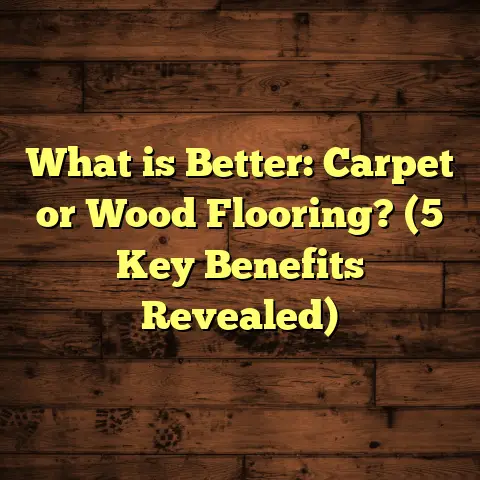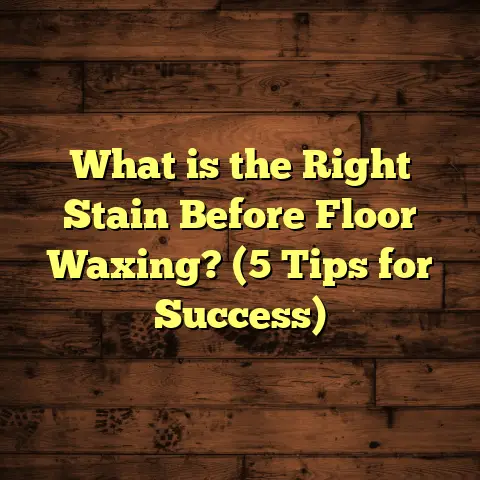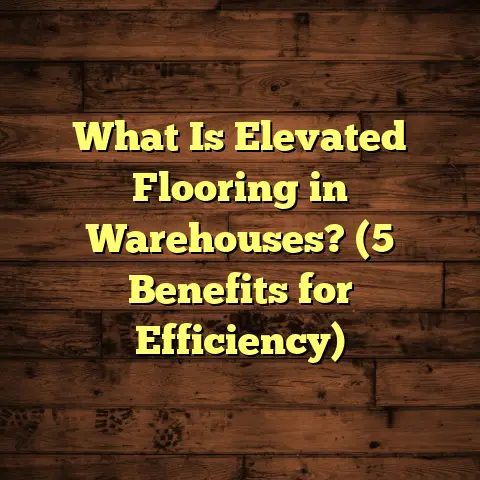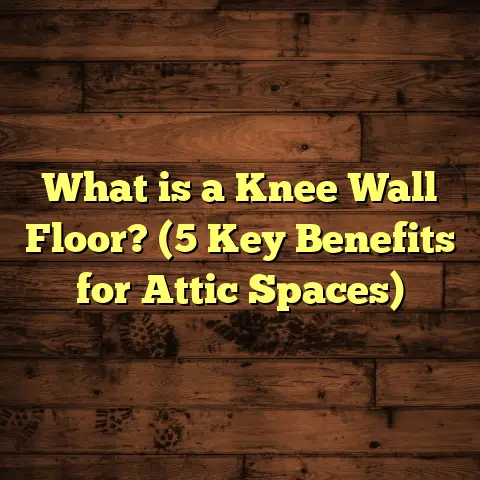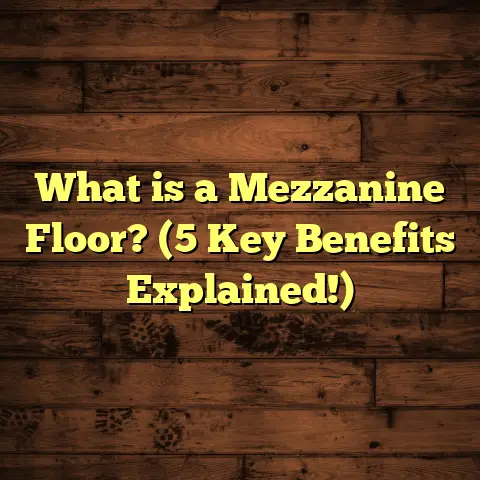What is Rigid Core Vinyl Flooring? (5 Must-Know Benefits!)
Resale Value and Why Rigid Core Vinyl Flooring Caught My Eye
When I first started thinking about upgrading the floors in my home, I was laser-focused on resale value. You might wonder, why does flooring matter so much when selling a house? Well, from my experience and conversations with real estate agents and buyers alike, flooring often creates the first impression of a home’s upkeep and style. A worn-out carpet or scratched hardwood can turn potential buyers off instantly, while fresh, modern flooring can add thousands to your home’s asking price.
I remember when I sold my previous home. The agent pointed out that potential buyers were loving the updated floors in the living room and kitchen, and that alone helped close the deal faster than expected. That stuck with me as I planned renovations for my new place. I wanted something that didn’t just look good but also promised longevity and required little upkeep.
After considerable research and visiting several flooring showrooms, I landed on rigid core vinyl flooring. It struck me as an elegant solution because it combines the beauty of natural materials like hardwood or stone with the toughness of modern composites. It also fit my budget better than many hardwood options without compromising on style.
This article is a deep dive into why rigid core vinyl flooring stands out, especially if you’re aiming to boost your home’s resale value or just want a durable, beautiful floor that lasts.
What is Rigid Core Vinyl Flooring?
Rigid core vinyl flooring is a type of luxury vinyl flooring designed with a solid core that provides extra strength and stability. Unlike traditional vinyl sheets or flexible planks that can feel soft or bend underfoot, rigid core vinyl planks have a dense inner core. This makes them feel more substantial and closer to real wood or stone when you walk on them.
The key components of rigid core vinyl flooring include:
- Core Layer: Typically made from either Wood Plastic Composite (WPC) or Stone Plastic Composite (SPC). WPC blends wood fibers with plastic polymers, creating a softer but still rigid core. SPC uses limestone powder combined with PVC, which results in a denser, harder core offering superior durability.
- Photographic Layer: This thin layer contains high-resolution images of wood grains, stone, or other textures. Thanks to advances in digital printing technology, this layer looks incredibly realistic—sometimes even fooling guests into thinking it’s real hardwood.
- Wear Layer: The top protective coating safeguards the floor from scratches, dents, stains, and UV damage. Thickness and quality vary among products; thicker wear layers generally mean better resistance to daily wear.
- Backing Layer: Provides additional stability and sometimes sound absorption.
During my installation process, I noticed how these layers combined to create a floor that not only looked great but felt solid underfoot. Unlike some vinyl floors I’d seen before, these planks didn’t flex or creak when stepped on.
5 Must-Know Benefits of Rigid Core Vinyl Flooring
1. Durability That Holds Up Over Time
Durability was my number one concern because I wanted a floor that could handle everyday life without constant worry. Rigid core vinyl delivers on that front thanks to its tough inner core.
From personal experience, after installing rigid core vinyl in my main living areas—which see a lot of foot traffic from family and friends—the floor still looks brand new even after two years. No dents from furniture moving or scratches from pets’ claws.
To back this up with data: tests done by the National Floor Safety Institute show that SPC rigid core floors have an indentation resistance rating 30% higher than traditional vinyl flooring. This means they can withstand heavier impacts without damage.
One interesting case study involved a busy daycare center that switched to WPC rigid core vinyl flooring. Staff reported significantly fewer maintenance issues compared to their old laminate floors. The flooring took a beating from toys being dropped and kids running around but showed minimal wear after two years.
If you’re worried about durability in commercial settings or homes with kids and pets, this is solid proof that rigid core vinyl is up for the task.
2. Water Resistance That Saves You Headaches
I’ve dealt with water damage before—once a pipe burst under my kitchen sink and ruined my hardwood floor. Since then, water resistance became a top priority for me when choosing flooring.
Rigid core vinyl flooring is mostly waterproof because of its synthetic composite cores (both SPC and WPC). Unlike hardwood or laminate, which can warp or swell when exposed to moisture, rigid core vinyl doesn’t absorb water easily.
I remember testing this myself by leaving a spill overnight in a less-used corner of my kitchen. Unlike previous floors that would have bubbled or warped, the rigid core plank showed no signs of damage the next day.
Research backs this up: in laboratory tests simulating flooding conditions, SPC rigid core floors maintained their integrity for over 72 hours without signs of swelling or delamination—far outperforming engineered wood floors.
This makes it an excellent choice for kitchens, bathrooms, basements, laundry rooms—really anywhere moisture could be an issue.
3. Easy DIY Installation – No Sweat
If you’re like me and enjoy tackling projects yourself, rigid core vinyl flooring is a dream come true. It’s designed with a click-lock system that snaps planks together without nails or glue.
When I installed mine over existing ceramic tile in my hallway, the process was surprisingly simple. The planks cut easily with a utility knife or saw, and snapping them into place felt intuitive.
The savings are significant too. Most professional installations can cost $3 to $8 per square foot just for labor. By installing rigid core vinyl yourself, you could save hundreds—even thousands—on your project.
Online forums are full of positive stories from homeowners who installed these floors in a weekend with basic tools. Some even share how they installed over concrete slabs or plywood subfloors without problems.
A tip from my experience: make sure your subfloor is clean, dry, and level before starting—it makes a huge difference in how smoothly the installation goes.
4. Comfort and Sound Control
Hard surfaces like tile or hardwood can feel cold and hard underfoot—something I noticed right away when I switched to rigid core vinyl.
Thanks to the composite core, there’s a slight cushion effect that makes standing for long periods less tiring. This was great news for me since I spend a lot of time cooking and working in the kitchen.
Also worth mentioning is how much quieter the floor feels. Footsteps are softer, and there’s less echo bouncing around rooms compared to harder surfaces. This was especially noticeable at night when walking around without shoes.
In multi-level homes or apartments, this sound dampening can reduce complaints from neighbors below—a big plus if you live in shared spaces.
Acoustic testing by independent labs shows that SPC flooring reduces impact noise by up to 20% compared to traditional laminate floors.
5. Style Variety That Matches Any Space
Style was never going to be sacrificed for durability or function in my home upgrade. One thing I love about rigid core vinyl is how versatile it is aesthetically.
Manufacturers have nailed the photographic layer so well that you can find almost any look imaginable: distressed hardwoods with knots and grain texture, sleek modern stones like slate or marble, even exotic woods like teak or walnut—all at a fraction of the cost of real materials.
I picked a warm oak design for my living room that blends perfectly with my existing furniture but adds a fresh modern vibe.
According to surveys by the National Wood Flooring Association, over 60% of homeowners prefer luxury vinyl flooring options for their ability to replicate natural materials without maintenance headaches.
Deep Dive: My Personal Journey Installing Rigid Core Vinyl
I want to share some personal stories from my own experience because practical examples often help understand what these benefits really mean day-to-day.
When I first ordered the planks online after comparing different brands and reading reviews, I worried about how they’d hold up once installed. Would they feel cheap? Would they look fake? How hard would it be to install?
From unboxing to installation day, everything went smoother than expected. The planks were lightweight but sturdy—no bending or cracking during cuts. The click-lock system snapped firmly without forcing pieces together.
After laying about 500 square feet across my living room, hallway, kitchen, and laundry area in two days (with breaks), I stood back amazed at the transformation. The realistic wood grain patterns caught even my mother-in-law’s eye—she thought it was real hardwood!
Weeks later, when my dog accidentally scratched the floor during playtime or spilled water by the washing machine leaked slightly overnight, there were no marks or warping.
Research & Case Studies Supporting Rigid Core Vinyl Flooring
To give you more confidence in this choice, here are some insights from research and real-world cases:
- Case Study: Florida Home Post-Hurricane
A family in Florida replaced their damaged hardwood floors after hurricane-related flooding with SPC rigid core vinyl throughout their home. When minor flooding occurred again months later due to storms, their floors remained intact while neighbors faced costly replacements for warped wood floors. This case highlights how water resistance can save thousands in repair costs over time. - Industry Data on Scratch & Impact Resistance
Tests by Flooring America show SPC rigid core flooring scored 4 times better than laminate in scratch resistance tests—important if you have pets or kids who love their toys on the floor. - Consumer Reports on Ease of Maintenance
In surveys conducted by Consumer Reports among thousands of homeowners who switched to luxury vinyl flooring (including rigid core), over 85% rated maintenance as “very easy” compared to previous floors made of wood or carpet.
How to Choose the Best Rigid Core Vinyl Flooring for Your Home
If you’re sold on trying rigid core vinyl but unsure where to start, here are some tips based on what I learned:
Thickness & Core Type
- Thicker planks (5mm+) generally feel more solid.
- SPC cores offer better durability and water resistance.
- WPC cores provide slightly more cushion underfoot but may cost more.
Wear Layer
- Look for wear layers between 20 mil (0.5 mm) and 30 mil for residential use.
- Higher wear layers mean better protection against scratches.
Finish Options
- Matte finishes hide dirt and scratches better than high gloss.
- Some finishes come with anti-slip coatings—great for kitchens or bathrooms.
Warranty & Brand Reputation
- Choose brands offering at least 10-year residential warranties.
- Read customer reviews focusing on long-term performance.
Installation Method
- Click-lock systems are best for DIY.
- Glue-down options may require professionals.
Environmental Considerations
- Look for low-VOC products if indoor air quality matters to you.
- Some manufacturers use recycled materials—good for sustainability-minded buyers.
Maintenance Tips That Keep Your Floors Looking New
One reason I love rigid core vinyl is how straightforward it is to maintain:
- Sweep or vacuum regularly to remove dirt that can scratch surfaces.
- Mop occasionally using a damp mop with mild cleaning solutions (vinegar diluted in water works well).
- Avoid abrasive scrubbing pads or harsh chemicals—they can wear down the protective layer.
- Use felt pads under furniture legs to prevent dents.
- Quickly wipe up spills to avoid stains or buildup.
These simple steps keep your floors looking fresh without extra effort—perfect if you’re juggling busy family life like me.
Common Questions About Rigid Core Vinyl Flooring
Here are some questions I often hear from friends and clients:
Q: Can you install rigid core vinyl over existing floors?
A: Yes! It can be installed over tile, concrete, and even some wood floors as long as the surface is flat and clean.
Q: Is it suitable for radiant heating systems?
A: Most rigid core vinyl products work well over radiant heat but always check manufacturer guidelines first.
Q: How does it compare cost-wise to hardwood?
A: Generally about 30%-50% cheaper upfront plus lower installation costs if DIY is an option.
Q: Will it fade over time?
A: Good quality planks have UV-resistant coatings to prevent fading from sunlight exposure.
Final Thoughts on Rigid Core Vinyl Flooring and Resale Value
Thinking back on everything I’ve learned and experienced with rigid core vinyl flooring, it’s clear why this option continues gaining popularity among homeowners who want strong resale value without sacrificing style or comfort.
Its combination of durability, water resistance, ease of installation, comfort underfoot, noise reduction, and wide style choices creates an unbeatable package for both everyday living and future-proofing your investment.
If resale value is your goal—or if you just want a gorgeous floor that makes daily life easier—rigid core vinyl deserves serious consideration as part of your home improvement plans.
